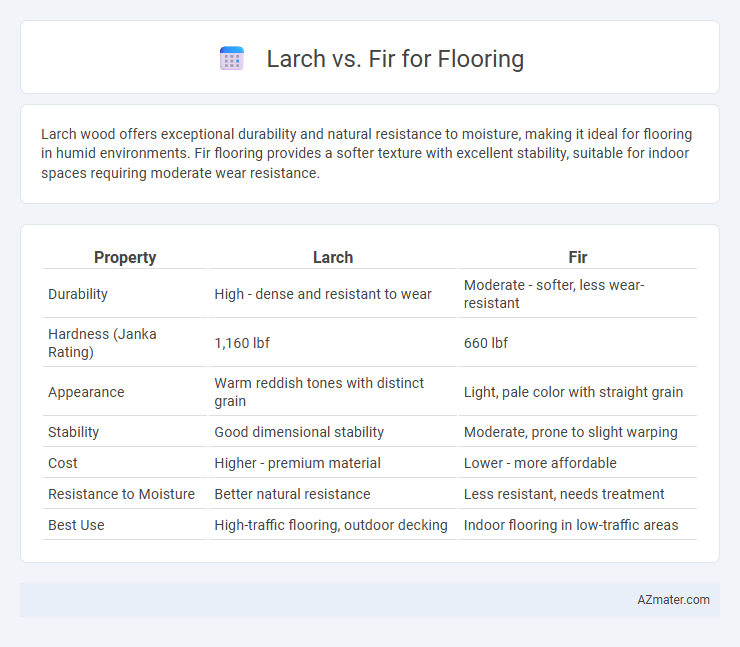Larch wood offers exceptional durability and natural resistance to moisture, making it ideal for flooring in humid environments. Fir flooring provides a softer texture with excellent stability, suitable for indoor spaces requiring moderate wear resistance.
Table of Comparison
| Property | Larch | Fir |
|---|---|---|
| Durability | High - dense and resistant to wear | Moderate - softer, less wear-resistant |
| Hardness (Janka Rating) | 1,160 lbf | 660 lbf |
| Appearance | Warm reddish tones with distinct grain | Light, pale color with straight grain |
| Stability | Good dimensional stability | Moderate, prone to slight warping |
| Cost | Higher - premium material | Lower - more affordable |
| Resistance to Moisture | Better natural resistance | Less resistant, needs treatment |
| Best Use | High-traffic flooring, outdoor decking | Indoor flooring in low-traffic areas |
Introduction to Larch and Fir Flooring
Larch flooring is prized for its natural durability and distinctive reddish hue, offering a rustic yet refined aesthetic suitable for both traditional and contemporary interiors. Fir flooring provides a softer texture with a light, warm tone, making it ideal for creating inviting and cozy spaces. Both larch and fir are resilient softwoods that deliver unique grain patterns and long-lasting performance in residential and commercial flooring applications.
Botanical Differences Between Larch and Fir
Larch (Larix spp.) and Fir (Abies spp.) differ significantly in botanical traits influencing flooring characteristics. Larch is a deciduous conifer, shedding needles annually, with denser, resin-rich wood offering exceptional durability and natural weather resistance. Fir is an evergreen conifer with softer, lighter wood prone to dents, favored for its uniform grain and stability in controlled indoor flooring environments.
Appearance and Color Variations
Larch flooring offers a rich, warm appearance with its golden to reddish-brown hues and distinctive knot patterns that add rustic charm and visual interest. Fir flooring features a more uniform, pale yellow to light reddish-brown color, providing a smoother and subtler texture ideal for contemporary interiors. Variations in larch tend to be bolder and more pronounced, while fir displays gentle, consistent color tones that enhance its understated elegance.
Hardness and Durability Comparison
Larch flooring offers a Janka hardness rating of approximately 1,150, providing moderate resistance to dents and wear, while fir ranks lower around 660, making it softer and more prone to surface damage. In terms of durability, larch is highly resilient due to its dense, resinous wood fibers, which resist moisture and decay better than fir, often resulting in longer-lasting flooring. Fir tends to be less durable in high-traffic or humid environments, requiring more maintenance to prevent scratches and damage compared to the robust performance of larch flooring.
Moisture Resistance and Stability
Larch wood offers superior moisture resistance due to its dense grain and natural resin content, making it less prone to warping and swelling in humid conditions compared to fir. Fir, while lighter and easier to work with, has lower dimensional stability and is more susceptible to moisture-induced deformation. For flooring applications requiring enhanced durability and stability in damp environments, larch is the preferable choice over fir.
Ease of Installation and Workability
Larch flooring boasts higher workability due to its softer texture, making it easier to cut, shape, and fasten during installation. Fir, being denser and harder, presents more challenges in nailing and cutting but offers greater durability once installed. Both species are well-suited for flooring, but larch provides a smoother installation process, particularly for DIY projects or less experienced installers.
Maintenance Requirements for Each Wood
Larch flooring offers high resistance to wear and moisture due to its dense grain, requiring minimal maintenance beyond regular sweeping and occasional sealing to preserve its durability and appearance. Fir flooring, while softer and more prone to dents or scratches, demands more frequent refinishing and moisture control to prevent warping and extend its lifespan. Both woods benefit from periodic cleaning with wood-specific products, but larch's natural resilience reduces overall maintenance intensity compared to fir.
Environmental Impact and Sustainability
Larch flooring offers a sustainable choice due to its rapid growth rate and high carbon sequestration, reducing overall environmental impact compared to slower-growing fir species. Fir wood, while durable, often comes from older forests, leading to longer regeneration times and higher ecological disruption. Choosing larch supports more sustainable forest management practices and lowers the carbon footprint associated with flooring production.
Cost Comparison: Larch vs Fir Flooring
Larch flooring generally costs more than fir due to its higher density and durability, which results in a longer lifespan and better resistance to wear. Fir flooring is typically more affordable, making it a popular choice for budget-conscious projects, but may require more frequent maintenance or replacement. Comparing the initial investment and long-term upkeep, larch offers a more cost-effective option despite the higher upfront price.
Best Applications and Recommendations
Larch wood offers excellent durability and water resistance, making it ideal for flooring in high-traffic areas and spaces prone to moisture, such as kitchens and entryways. Fir flooring is softer and less dense, suited for low-traffic residential rooms where warmth and aesthetic appeal are prioritized over heavy wear resistance. For long-lasting flooring with natural resilience, larch is recommended, while fir is best applied in decorative or light-use flooring projects.

Infographic: Larch vs Fir for Flooring
 azmater.com
azmater.com